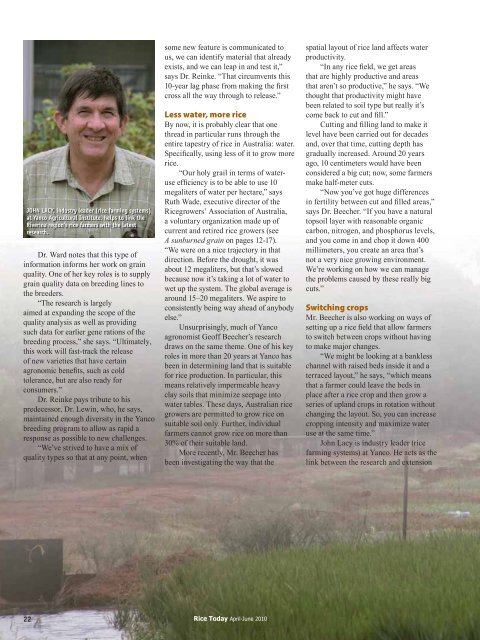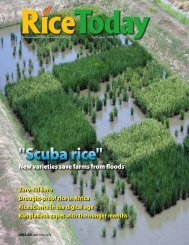A sunburned grain Stamps of approval Pockets of gold in ... - adron.sr
A sunburned grain Stamps of approval Pockets of gold in ... - adron.sr
A sunburned grain Stamps of approval Pockets of gold in ... - adron.sr
You also want an ePaper? Increase the reach of your titles
YUMPU automatically turns print PDFs into web optimized ePapers that Google loves.
JOHN LACY, <strong>in</strong>dustry leader (rice farm<strong>in</strong>g systems)at Yanco Agricultural Institute, helps to l<strong>in</strong>k theRiver<strong>in</strong>a region’s rice farmers with the latestresearch.Dr. Ward notes that this type <strong>of</strong><strong>in</strong>formation <strong>in</strong>forms her work on <strong>gra<strong>in</strong></strong>quality. One <strong>of</strong> her key roles is to supply<strong>gra<strong>in</strong></strong> quality data on breed<strong>in</strong>g l<strong>in</strong>es tothe breeders.“The research is largelyaimed at expand<strong>in</strong>g the scope <strong>of</strong> thequality analysis as well as provid<strong>in</strong>gsuch data for earlier gene rations <strong>of</strong> thebreed<strong>in</strong>g process,” she says. “Ultimately,this work will fast-track the release<strong>of</strong> new varieties that have certa<strong>in</strong>agronomic benefits, such as coldtolerance, but are also ready forconsumers.”Dr. Re<strong>in</strong>ke pays tribute to hispredecessor, Dr. Lew<strong>in</strong>, who, he says,ma<strong>in</strong>ta<strong>in</strong>ed enough diversity <strong>in</strong> the Yancobreed<strong>in</strong>g program to allow as rapid aresponse as possible to new challenges.“We’ve strived to have a mix <strong>of</strong>quality types so that at any po<strong>in</strong>t, whensome new feature is communicated tous, we can identify material that alreadyexists, and we can leap <strong>in</strong> and test it,”says Dr. Re<strong>in</strong>ke. “That circumvents this10-year lag phase from mak<strong>in</strong>g the firstcross all the way through to release.”Less water, more riceBy now, it is probably clear that onethread <strong>in</strong> particular runs through theentire tapestry <strong>of</strong> rice <strong>in</strong> Australia: water.Specifically, us<strong>in</strong>g less <strong>of</strong> it to grow morerice.“Our holy grail <strong>in</strong> terms <strong>of</strong> wateruseefficiency is to be able to use 10megaliters <strong>of</strong> water per hectare,” saysRuth Wade, executive director <strong>of</strong> theRicegrowers’ Association <strong>of</strong> Australia,a voluntary organization made up <strong>of</strong>current and retired rice growers (seeA <strong>sunburned</strong> <strong>gra<strong>in</strong></strong> on pages 12-17).“We were on a nice trajectory <strong>in</strong> thatdirection. Before the drought, it wasabout 12 megaliters, but that’s slowedbecause now it’s tak<strong>in</strong>g a lot <strong>of</strong> water towet up the system. The global average isaround 15–20 megaliters. We aspire toconsistently be<strong>in</strong>g way ahead <strong>of</strong> anybodyelse.”Unsurpris<strong>in</strong>gly, much <strong>of</strong> Yancoagronomist Ge<strong>of</strong>f Beecher’s researchdraws on the same theme. One <strong>of</strong> his keyroles <strong>in</strong> more than 20 years at Yanco hasbeen <strong>in</strong> determ<strong>in</strong><strong>in</strong>g land that is suitablefor rice production. In particular, thismeans relatively impermeable heavyclay soils that m<strong>in</strong>imize seepage <strong>in</strong>towater tables. These days, Australian ricegrowers are permitted to grow rice onsuitable soil only. Further, <strong>in</strong>dividualfarmers cannot grow rice on more than30% <strong>of</strong> their suitable land.More recently, Mr. Beecher hasbeen <strong>in</strong>vestigat<strong>in</strong>g the way that thespatial layout <strong>of</strong> rice land affects waterproductivity.“In any rice field, we get areasthat are highly productive and areasthat aren’t so productive,” he says. “Wethought that productivity might havebeen related to soil type but really it’scome back to cut and fill.”Cutt<strong>in</strong>g and fill<strong>in</strong>g land to make itlevel have been carried out for decadesand, over that time, cutt<strong>in</strong>g depth hasgradually <strong>in</strong>creased. Around 20 yearsago, 10 centimeters would have beenconsidered a big cut; now, some farmersmake half-meter cuts.“Now you’ve got huge differences<strong>in</strong> fertility between cut and filled areas,”says Dr. Beecher. “If you have a naturaltopsoil layer with reasonable organiccarbon, nitrogen, and phosphorus levels,and you come <strong>in</strong> and chop it down 400millimeters, you create an area that’snot a very nice grow<strong>in</strong>g environment.We’re work<strong>in</strong>g on how we can managethe problems caused by these really bigcuts.”Switch<strong>in</strong>g cropsMr. Beecher is also work<strong>in</strong>g on ways <strong>of</strong>sett<strong>in</strong>g up a rice field that allow farmersto switch between crops without hav<strong>in</strong>gto make major changes.“We might be look<strong>in</strong>g at a banklesschannel with raised beds <strong>in</strong>side it and aterraced layout,” he says, “which meansthat a farmer could leave the beds <strong>in</strong>place after a rice crop and then grow aseries <strong>of</strong> upland crops <strong>in</strong> rotation withoutchang<strong>in</strong>g the layout. So, you can <strong>in</strong>creasecropp<strong>in</strong>g <strong>in</strong>tensity and maximize wateruse at the same time.”John Lacy is <strong>in</strong>dustry leader (ricefarm<strong>in</strong>g systems) at Yanco. He acts as thel<strong>in</strong>k between the research and extension22Rice Today April-June 2010

















